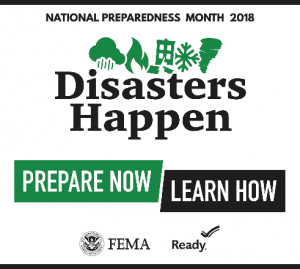
Week 1: September 1-8 – Make and Practice Your Plan
Make a plan today. Your family may not be together if a disaster strikes, so it is important to know which types of disasters could affect your area. Know how you’ll contact one another and reconnect if separated. Establish a family meeting place that’s familiar and easy to find.
Step 1: Put together a plan by discussing these 4 questions with your family, friends, or household to start your emergency plan.
- How will I receive emergency alerts and warnings?
- What is my shelter plan?
- What is my evacuation route?
- What is my family/household communication plan?
Step 2: Consider specific needs in your household.
As you prepare your plan tailor your plans and supplies to your specific daily living needs and responsibilities. Discuss your needs and responsibilities and how people in the network can assist each other with communication, care of children, business, pets, or specific needs like the operation of durable medical equipment. Create your own personal network for specific areas where you need assistance. Keep in mind some these factors when developing your plan:
- Different ages of members within your household
- Responsibilities for assisting others
- Locations frequented
- Dietary needs
- Medical needs including prescriptions and equipment
- Disabilities or access and functional needs including devices and equipment
- Languages spoken
- Cultural and religious considerations
- Pets or service animals
- Households with school-aged children
Step 3: Fill out a Family Emergency Plan
Download and fill out a family emergency plan or use them as a guide to create your own.
Step 4: Practice your plan with your family/household
Week 2: September 9-15-Learn Life Saving Skills
- Know basic home maintenance to protect your family and home. Learn how to mitigate your home against flood damage, or protect against the impacts of earthquakes.
- Learn how to turn off utilities like natural gas in your home.
- Put smoke alarms on every level of your home, test them monthly, and replace them when they are 10 years old.
- Know the ways to keep your home safe from cooking, heating & electrical fires.
- On National Day of Action, Saturday, September, 15, hold a preparedness event. Some examples of events might be hosting a CPR class or Community Emergency Response Team (CERT) training at your business, school, or house of worship; or volunteering with a local disaster response or recovery agency.
Week 3: Sept 16-22-Check Your Insurance Coverage
- Insurance is the first line of defense; check your insurance coverage and review the Document and Insure Property guide.
- Flood Insurance allows communities and families to recover more quickly and more fully. Visit Floodsmart.gov to learn more about flood insurance and how to protect your home or business.
Week 4: Sept 23-30-Save For an Emergency
- Plan financially for the possibility of disaster.
- Complete an Emergency Financial First Aid Kit (EFFAK)
- Maintain emergency savings for use in case of an emergency
Resources:
Ready.gov National Preparedness Month


